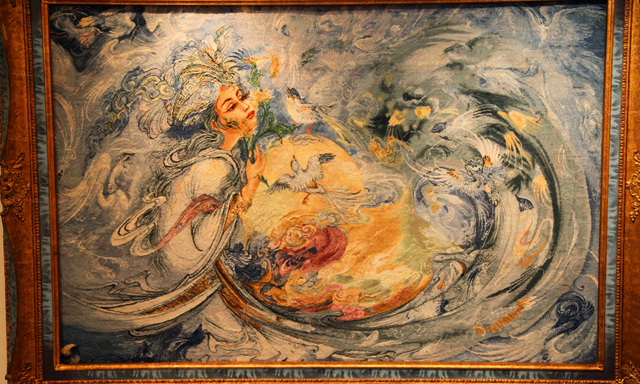Have you ever considered buying a Persian rug? Andy Mills visits the Center of Original Iranian Carpets and finds out that no matter how much or how little you spend, each one is something to cherish.
Step inside the Center of Original Iranian Carpets (COIC) just off the Corniche and you’re transported into a world of legend, philosophy, magic and artistry that will leave you spellbound. The carpets hanging from the walls, stacked in colourful piles on the floor or rolled up in corners all tell a story; unique works by skilled artists that have the threads of Middle Eastern history weaved into their delicate patterns.
Dawood Hosseinzadeh steps out from the back of the impressive showroom, greeting us with an infectious smile. His family have been traders of fine Persian carpets since 1920 and established themselves in Abu Dhabi in 1974, leaving behind an increasingly precarious Iran.
He’s a softly spoken and charming host, whose passion for the Persian carpets, so entwined in his family history, is evident from the moment he starts to talk. ‘This craftsmanship has been around for thousands of years,’ he explains. ‘The Pazryk carpet found by Professor Rudenko preserved in ice in the Altai Mountains of Siberia is the oldest existing specimen, dating back 2,500 years. It’s definitely Persian, you can see this from the crests at the centre, the colours and the horsemen on the outside, so similar to those found in old Persepolis.’
He goes on to run through the history of Persian carpets with the same unrelenting enthusiasm, explaining how the colours can give away which region they are from (due to the types of dye available and quality of water), the process of drawing the design, buying and dying the wool and the tools and techniques that create each handmade carpet.
Did you know the weaver creates freehand from the design, but will not see how it has turned out until the excess wool or silk has been sheared? A perfectly executed carpet is therefore what all expert weavers strive for.
‘We have around 5,000 carpets here and I believe I know 90 percent of them individually,’ says Dawood. ‘Everything here apart from me is carpet.’ He walks around the showroom, pulling carpets from behind carpets and under piles showing the different styles, the pictorial designs based on poems of Persian philosopher Omar Khayyam and even a selection of the simply patterned tribal rugs.
‘Persian carpets have been part of aristocracy and are still part of the elite,’ says Dawood seriously. ‘But there are many affordable daily use carpets that are still art under foot. A simple rug can be a couple of thousand dirhams. They are practical but still beautiful art.’
He’s not a hard salesman when it comes to his carpets either; rather he would prefer customers to visit the showroom on a number of occasions and find the one that they are truly happy with. ‘This is something that if kept properly can be the wealth of a family. They can be something your children are born and grow up with. They can be the nostalgia of your childhood. In Iran, some banks would even take your carpet as collateral against a loan if you fell on hard times.’
So devoted to the art of Persian carpets and the telling of their stories is Dawood, that he and the staff are more than happy for people to visit the COIC showroom and treat it like a museum, taking their time to look around and learn more than could possibly ever be written here. Consider that an invitation then, but be warned, the magic of these special carpets could have you trying to conjure up ways to take one home.
Center of Original Iranian Carpets, Corniche (02 681 1156).
Buying guide
There are three types of Persian carpet material:
• Wool The most functional, ideal for daily use and are often the least expensive.
• Wool/silk Like wool carpets but more expensive. Perfect balance of beauty and practicality.
• Pure silk Best for hanging or occasional use in quieter areas due to being difficult to clean.
The value is determined by:
• Design The more detailed and unique designs are likely to be more expensive.
• Colours The more colours and greater density and durability, the greater value.
• Material Different types of wool or silk can affect the value.
• Density The higher the number of knots in a square metre the greater the quality.
Key thing to remember:
You can buy a Persian carpet solely as an investment, but it is wiser to choose one that you enjoy as well.









